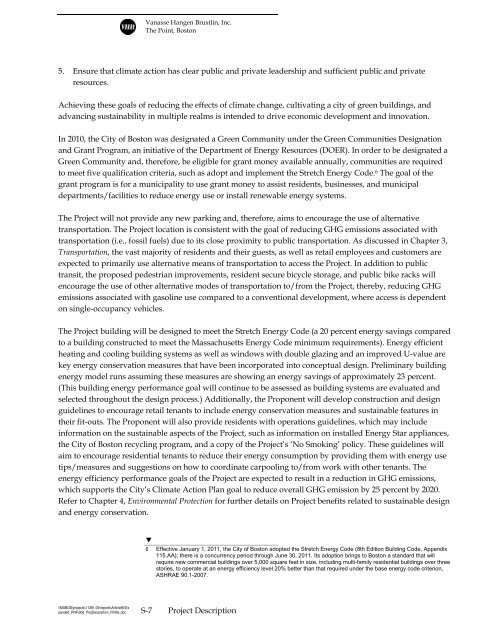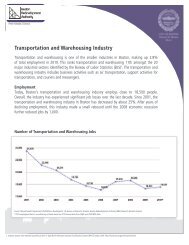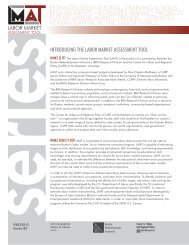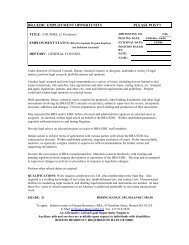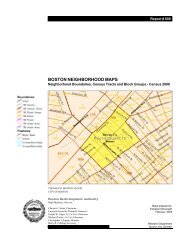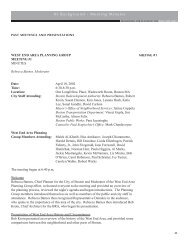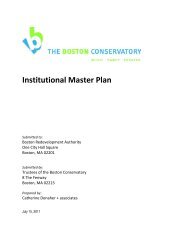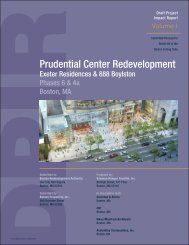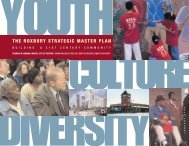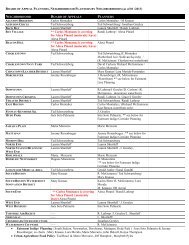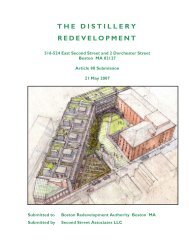point cover jan 13 - Boston Redevelopment Authority
point cover jan 13 - Boston Redevelopment Authority
point cover jan 13 - Boston Redevelopment Authority
You also want an ePaper? Increase the reach of your titles
YUMPU automatically turns print PDFs into web optimized ePapers that Google loves.
Vanasse Hangen Brustlin, Inc.<br />
The Point, <strong>Boston</strong><br />
5. Ensure that climate action has clear public and private leadership and sufficient public and private<br />
resources.<br />
Achieving these goals of reducing the effects of climate change, cultivating a city of green buildings, and<br />
advancing sustainability in multiple realms is intended to drive economic development and innovation.<br />
In 2010, the City of <strong>Boston</strong> was designated a Green Community under the Green Communities Designation<br />
and Grant Program, an initiative of the Department of Energy Resources (DOER). In order to be designated a<br />
Green Community and, therefore, be eligible for grant money available annually, communities are required<br />
to meet five qualification criteria, such as adopt and implement the Stretch Energy Code. 6 The goal of the<br />
grant program is for a municipality to use grant money to assist residents, businesses, and municipal<br />
departments/facilities to reduce energy use or install renewable energy systems.<br />
The Project will not provide any new parking and, therefore, aims to encourage the use of alternative<br />
transportation. The Project location is consistent with the goal of reducing GHG emissions associated with<br />
transportation (i.e., fossil fuels) due to its close proximity to public transportation. As discussed in Chapter 3,<br />
Transportation, the vast majority of residents and their guests, as well as retail employees and customers are<br />
expected to primarily use alternative means of transportation to access the Project. In addition to public<br />
transit, the proposed pedestrian improvements, resident secure bicycle storage, and public bike racks will<br />
encourage the use of other alternative modes of transportation to/from the Project, thereby, reducing GHG<br />
emissions associated with gasoline use compared to a conventional development, where access is dependent<br />
on single-occupancy vehicles.<br />
The Project building will be designed to meet the Stretch Energy Code (a 20 percent energy savings compared<br />
to a building constructed to meet the Massachusetts Energy Code minimum requirements). Energy efficient<br />
heating and cooling building systems as well as windows with double glazing and an improved U-value are<br />
key energy conservation measures that have been incorporated into conceptual design. Preliminary building<br />
energy model runs assuming these measures are showing an energy savings of approximately 23 percent.<br />
(This building energy performance goal will continue to be assessed as building systems are evaluated and<br />
selected throughout the design process.) Additionally, the Proponent will develop construction and design<br />
guidelines to encourage retail tenants to include energy conservation measures and sustainable features in<br />
their fit-outs. The Proponent will also provide residents with operations guidelines, which may include<br />
information on the sustainable aspects of the Project, such as information on installed Energy Star appliances,<br />
the City of <strong>Boston</strong> recycling program, and a copy of the Project’s ‘No Smoking’ policy. These guidelines will<br />
aim to encourage residential tenants to reduce their energy consumption by providing them with energy use<br />
tips/measures and suggestions on how to coordinate carpooling to/from work with other tenants. The<br />
energy efficiency performance goals of the Project are expected to result in a reduction in GHG emissions,<br />
which supports the City’s Climate Action Plan goal to reduce overall GHG emission by 25 percent by 2020.<br />
Refer to Chapter 4, Environmental Protection for further details on Project benefits related to sustainable design<br />
and energy conservation.<br />
<br />
6 Effective January 1, 2011, the City of <strong>Boston</strong> adopted the Stretch Energy Code (8th Edition Building Code, Appendix<br />
115.AA); there is a concurrency period through June 30, 2011. Its adoption brings to <strong>Boston</strong> a standard that will<br />
require new commercial buildings over 5,000 square feet in size, including multi-family residential buildings over three<br />
stories, to operate at an energy efficiency level 20% better than that required under the base energy code criterion,<br />
ASHRAE 90.1-2007.<br />
\\MABOS\projects\1<strong>13</strong>81.00\reports\Article80\Ex<br />
panded_PNF\00d_ProjDescription_FINAL.doc S-7 Project Description


